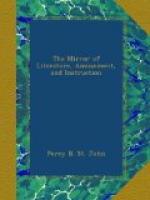In order more readily to show one effect, let the horses be considered only 1,000; a smaller number may not make the argument so difficult. Let us reduce this number, and the farmer may then turn his oat-ground into wheat-ground; and instead of so much land being employed to furnish food for a thousand horses, the same land, when turned into tillage fit to sow wheat upon, will produce sufficient bread-corn to feed two thousand poor families.
Again, if instead of 20,000 horses, we keep 30,000 fat oxen, butchers’ meat will be always cheap to the operative classes, whilst the quantity of tallow will of course make candles cheap: and so many hides lower the price of leather, and of shoes and all other articles made of leather. Or the same quantity of land may then keep thirty thousand cows, the milk of which will make both butter and cheese cheaper to the poor, as well as the labouring manufacturer; all which articles are very considerable, and of material moment in the prices of our manufacturers, as they, in a great measure, work their trade to rise and fall in price, according to the cheapness of their materials and the necessaries of life. The same may be said in favour of more sheep and woollen cloths.
(To be concluded in our next.)
* * * * *
THE EXPECTED COMET.
The comet of Biela is approaching the earth’s orbit with increasing velocity, and towards the end of the following month it will partially intersect the course which the earth traverses in its journey round the sun. Happily, the comet will be in advance of the earth, so that unless our globe augments its pace, or the anticipated visitant retards its journey, there will be no risk of any dangerous proximity, much less of a hostile collision. During this return, at least, it will always be more than two hundred times the moon’s distance from us; and were it, at any future time, to approach very much nearer than the orbit of our satellite, its influence would be too inconsiderable to affect any of the elements of the earth’s path.
This comet is about 40,000 miles in diameter, and of that class termed nebulous, having no tail, and probably no solid nucleus. The point where the comet’s centre crosses the plane of the ecliptic is within and very near the curve which the earth describes,—so very near, that the outskirts of the nebulous matter of the comet might possibly, at some future visit, envelope our planet, and would thus enclose the earth, it is not unlikely, at its ensuing return, if it were about a month later than the time calculated, of its intersecting the plane of the earth’s motion.
The presence of the moon during the past week has interfered with telescopic observations, or probably the comet might have been detected as a small round nebulosity, moving midway between the northern horn of Taurus and the bright star Capelle, towards Gemini. There are nebulae near its course for which it must not be mistaken.




